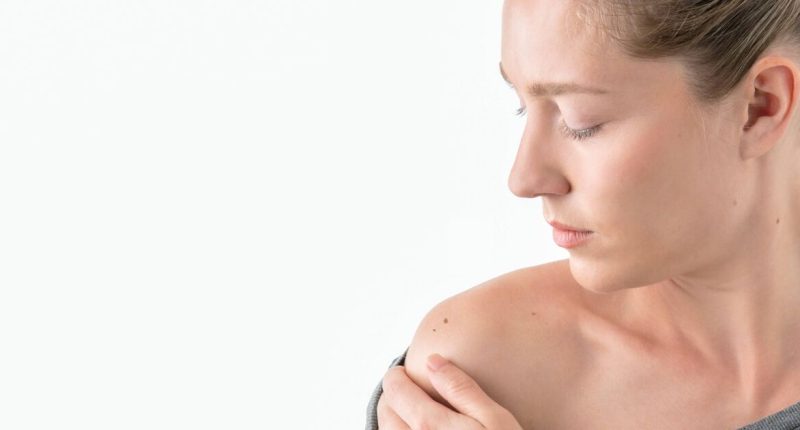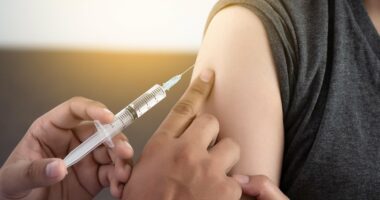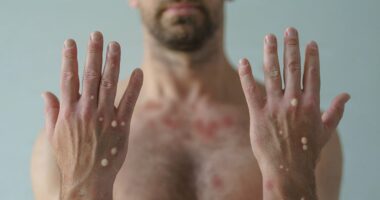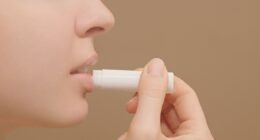Share this @internewscast.com

There’s a rule to follow (Image: SCIENCE PHOTO LIBRARY via Getty Images)
The emergence of a new blemish or discolouration on the skin can be alarming, especially for those who have been soaking up the sun rays. While these spots are often benign age spots, they could also signal melanoma, the most serious type of skin cancer.
It’s crucial to distinguish between the two, as they can appear strikingly similar. Here’s how you can tell if that new spot is merely superficial or a sign that you need to consult a doctor immediately.
How to differentiate age spots from melanoma
Despite their visual similarities, age spots are completely benign, unlike melanoma. “Age spots – also known as sunspots and liver spots – are flat, brown areas on sun-exposed areas of the skin,” says Dr Chris Harland, a consultant dermatologist at Nuffield Health. “Dermatologists refer to them as solar lentigos.”
These spots are typically seen in fair-skinned individuals over 50 years old, particularly in those with a history of extensive sun exposure. Not only the sun but also tanning beds can lead to the formation of age spots.
“Age spots are usually flat and smooth and less than a centimetre in diameter,” Harland notes. “I find it useful to reassure patients that when they develop a light brown flat spot, which is the colour of coffee with added milk, then it is very likely to be safe.”

Even benign lesions are subject to change (Image: Alamy/PA)
However, distinguishing between lentigos can be a challenge when they present in varying shades of brown. “Melanomas – which are much rarer – can occur as flat spreading, irregular and dark or even black spots,” Harland says.
“They may have at least two shades of brown, black or even pink. Whilst safe when flat, they can become lumpy (invasive) and dangerous.”
Harland recommends that anyone with concerning lesions should seek an evaluation from a GP or dermatologist, who can utilise a specialised microscope known as a dermascope.
Can age spots turn cancerous?
Although age spots are typically benign, there is a risk they could evolve into something more sinister. “Age spots can change and they can see benign changes and cancerous ones,” says Dr Unnati Desai, national dermatology lead at Nuffield Health.
“Benign changes can include non-cancerous thickened and/or rough textures,” she continues. “Cancerous changes, also known as lentigo maligna, a precursor to melanoma, and lentigo maligna melanoma, often start with what looks like a benign age spot but will change to have an atypical look such as a larger size, irregular shape, changed texture or height or have multiple colours – like tan, dark brown, black, pink, red and white. It’s also important to look out for ulceration and bleeding.”
Therefore, it’s vital to regularly inspect any age spots or lesions that have been previously identified as harmless.

Applying SPF daily can prevent both age spots and melanoma (Image: Alamy/PA)
When to consult a dermatologist
If you observe any alterations in existing skin lesions or the emergence of new ones, it’s crucial to seek medical advice. “One of the easiest ways to check for potential signs of melanoma is by using the ABCDE rule,” explains Dr Desai.
“A stands for asymmetry in shape. B represents a border that is irregular. C signifies colour that is uneven, or comprises different shades – such as black, brown or pink. D denotes diameter, like increases in size and E embodies elevation and evolution, where the lesion becomes raised off the skin or undergoes other changes such as bleeding, or becoming crusty, itchy, ulcerated, or inflamed.
“I also recommend taking pictures of any concern areas every three to six months, comparing the latest with the previous images to monitor the skin and any changes. If any changes are noticed by the naked eye, then see a doctor for an examination with a dermascope,” she says.
How your beauty treatments can impact melanoma
You might be tempted to address pigmentation issues with lasers, creams or masks. However, certain beauty treatments could hinder the detection of a melanoma.
“Before treating any skin lesion, you should consult your doctor for an appropriate examination – usually with a dermascope or biopsy – to ensure there are no features suggestive of skin cancer,” explains Desai.
This is especially critical if the treatment involves cell destruction. “Following any treatment, a review with your doctor is recommended to monitor any recurrence or abnormal healing,” she advises.
“Creams, such as retinoids and hydroquinone, have a limited effect on the cosmetic appearance of age spots,” explains Dr Harland. “Gentle freezing – known as cryotherapy, laser or intense pulsed light can remove them.
“However, these cosmetic treatments are not available through the NHS and can be expensive,” he adds. “Treated lesions may also recur.”

Here’s how to identify melanoma (Image: Alamy/PA)
Protection and prevention
While daily SPF usage is now more or less standard practice, there are some crucial factors to consider when it comes to safeguarding your skin and warding off melanoma.
“From an early age, it is important to avoid sunburn, especially for those with fair skin,” advises Harland. “However, age spots are associated with an overall lifetime exposure to ultraviolet, not just sunburns, so a good level of protection will help prevent them from occurring.”
Applying a quality mineral or chemical SPF daily is the most effective measure you can take to prevent both age spots and melanoma.
“This means using a daily sunblock, even in the winter months,” Desai recommends. “Use a sunscreen with a star rating of three to five, protecting from UVA radiation and an SPF rating of 30-50, protecting from UVB radiation.”
Look out for ingredients like zinc oxide and titanium dioxide – found in mineral sunscreens – which serve as physical UV barriers.
“In the summer months, an SPF minimum of 30 is needed, especially if you’re sitting or lying in the sunlight,” advises Desai. “When going abroad to warmer climates, this should be a minimum of an SPF 50. Wear clothes that cover the skin if spending a longer period of time outdoors. In winter months, an SPF of 12 to 15 is adequate for day-to-day use.”

















